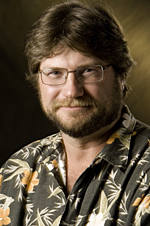
New Mexico Highlands University was awarded a $333,461 National Science Foundation grant for groundbreaking hydrogeological research in the Central High Plains Aquifer, which supplies nearly 30 percent of the groundwater in the U.S.
Environmental geology professor Michael Petronis wrote the university’s grant for the study that will produce the first subsurface geologic map of the aquifer, providing vital information for future water management.
Petronis is collaborating on the aquifer research with University of Kansas geology professor Jon Smith. K.U. was awarded a separate NSF grant for the joint research project.
“Groundwater is a finite, non-renewable resource, and it’s imperative that we fully understand the Ogallala Aquifer because it serves as the primary water resource in the eastern High Plains,” Petronis said.
The Ogallala Aquifer is a rock unit that formed approximately 24 million years ago, when woolly mammoths roamed the region.
“The goal of this research is to model groundwater flow throughout the High Plains aquifer. This will give state and local agencies information to manage water resources more effectively in a sustainable manner,” Petronis said.
The modeling will help predict hydrogeological response to different groundwater management strategies.
Historic declines in water levels in the Central High Plains Aquifer have created growing concerns about the long-term sustainability of the aquifer, one of the largest in the world.
The aquifer supports an estimated 12.7 million acres of irrigated land in New Mexico, Texas, Colorado, Oklahoma, Kansas, Nebraska, South Dakota and Wyoming. The majority of the population in this region also relies on the aquifer for domestic uses.
Petronis said global climate change resulting in a more arid climate, combined with growing population and agricultural use, has increased demand for the groundwater in the aquifer study region.
“Wells are being dug deeper and deeper in the High Plains aquifer with limited success,” Petronis said.
This summer Petronis and Smith will drill seven deep core samples throughout the aquifer. Eastern New Mexico and western Kansas are a special focus for the study area.
The two geologists will use a state-of-the-art mobile mounted platform drilling rig with a two-inch core barrel to retrieve core samples up to 360 feet long.
“These rock core samples preserve a record of geological change, and by understanding the age and distribution of the rocks in the study area, we’ll be better able to understand the aquifer,” Petronis said.
His research will examine the magneto stratography of the rock samples, mapping the direction of the earth’s magnetic field over time, which determines the age of the rocks.
This geological mapping has important implications for how water flows through the aquifer.
Several hundred rock samples from each of the seven study areas will be analyzed in Highlands University’s cutting-edge paleomagnetic laboratory, used to study magnetic properties of earth materials. The lab is one of only two in the state and was established in 2008 with an NSF grant.
The three-year NSF grant for the Central High Plains Aquifer research will fund student research opportunities in the paleomagnetic lab.
“It’s a chance for our geology students to see first-hand how a large-scale hydrogeological study is conducted, and produce their own original research,” Petronis said.
The grant will also fund a geology post-doctoral fellowship for Kate Zeigler. Her research will help with the extensive lab analysis for the core samples, and she will also teach introductory geology courses.
According to the NSF, the Central High Plains Aquifer study has future global implications for aquifers in other parts of the world that have similar hydrogeology, and are also experiencing strain on groundwater resources.
“Greater understanding of the high plains aquifer will allow scientists to better model other complex aquifers worldwide,” Petronis said.
